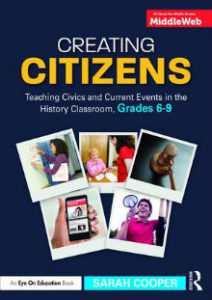Making Annotations with Less Pain, More Meaning
A MiddleWeb Blog
 I’m an annotation geek, and my students know it.
I’m an annotation geek, and my students know it.
Whether in English or history, I’m that teacher: the one who asks students to interact constantly with the text as they read. This could be in the margins if they’re looking at a handout, on a separate page if they’re doing research in a library book, or onscreen if they are using an electronic annotation platform (Common Sense Education highlights 19 in this article).
In fact, one of my favorite moments of professional growth came recently when our librarians presented a workshop to teachers on annotating sources in the Gale databases, such as In Context: U.S. History. I couldn’t believe how useful the program’s highlighting function was for helping students see information graphically, and a colleague said she has rarely seen me so excited.
Over the years I’ve heard many (many!) students complain about the time it takes to annotate a text, and I empathize with the idea that marking up articles or books can interrupt the reading flow. However, such written engagement with a text – especially a nonfiction one – is the best way I know both to remember what we read and to ensure symbiosis between readers’ and authors’ ideas.
At its best, annotation starts a dialogue between our students and great thinkers of past and present. The act of writing something down implies that these adolescents must be active consumers of information, not simply passive ingesters of knowledge—a key element of engaged citizenship.
Offering a Way In

From CommonLit
Many of us use CommonLit regularly for its free, concise, grade-appropriate fiction and nonfiction pieces. I also like it because it builds in thoughtful annotation prompts for every article. Including such a guideline means that students will take away what is most important about the news article, literary excerpt or historical primary source.
For example, in an article by Jason Beaubien giving “5 Surprising Facts About the Refugee Crisis,” the introduction prompts: “As you read, take notes on what obstacles people displaced from their homes encounter while trying to find safety.” This kind of focus can inspire students to become more globally aware.
In addition to students’ taking notes on the facts themselves, I also like to encourage them to listen to their own emotional reaction. Reading a statistic such as the following – “In 2016 alone, according to UNHCR, 75,000 children applied for asylum as unaccompanied minors” – invites empathy.
Doing “emotional annotations,” in conjunction with straight facts, can lead beautifully into a discussion question such as this one from a different CommonLit article on the same topic: “What is the obligation of other countries to intervene when they see people suffering?”
Doing Research: Moving to More Targeted Annotations
By the time we arrive at our major 8th grade spring research project, an exploration of a U.S. reformer, students are accustomed to doing annotations because they mark up a current events article for homework each Friday. My standard directions are to write at least six comments on two or more pages of a newspaper or magazine article.
For these weekly annotations on a news piece of their choice, students can focus on any number of elements relating to facts, quotations or statistics, such as:
- Surprise – what shocks you enough to want to tell someone else?
- Empathy – where did you feel especially connected to the people in the story?
- Confusion – what didn’t make sense to you?
- Depth – what helped you understand something better?
Usually I tell students they can write anything they like as long as it’s reasonably complex: not simply “wow” but “unusual approach to homelessness,” for instance.
As we work on a larger research project, I’ll usually suggest that students annotate two to three pages of a source, not necessarily starting at the beginning. In a biographical sketch, often the most relevant information about a reformer’s later impact comes after the introductory material about that person’s childhood.
Sometimes students come across more difficult pieces, such as primary source documents on the Library of Congress or Gilder Lehrman sites, or scholarly articles on the open source CORE or the fee-based ProQuest Research Library.
With journal articles, I ask students first to read the abstract to see if they can understand it and if the piece is relevant to their topic. If yes to both, then they’ll select the equivalent of two or more pages, often part of the discussion or the conclusion.

LOC: Reformer Lewis Hine‘s photo of a child laborer in 1913
As they do annotations for their reformer research, students focus their margin comments on the reformer’s tactics, strategies, and/or personality traits. This list has the double effect of helping them write their eventual paper, as well as narrowing the annotations so their topic statements do not become overly broad.
Ideally, such targeted annotations can lead to deeper understanding and build the framework for a meaningful student essay or research paper.
Which ways have you found work best for students to annotate?



































